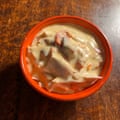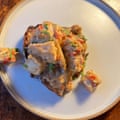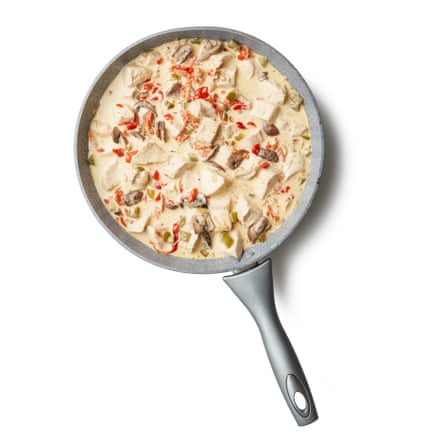Despite its regal branding, chicken à la king reminds me of school dinners. How the mighty have fallen: the boozy, truffle-laced treat of the early 20th century reduced to rubbery chicken in a floury white sauce by its close. But, though the dish seems to have been created in the restaurants of the US rather than the royal palaces of Europe (the legendary New York Times food editor Craig Claiborne remembered it as “standard party fare” during his 1920s Southern childhood), it’s still a sound choice for coronation celebrations.
First, because the name fits, second, because both chicken and cream are perennial crowdpleasers, and third, because it’s perfect buffet fare – as the Oxford Encyclopaedia of Food and Drink in America notes, in its heyday, the dish was particularly popular in tearooms, because it “could be eaten in a most ladylike way without picking up a knife”. Which also makes it ideal for consumption around the television set, or at a street party, should either of those figure in your plans. And if you’re ignoring the whole affair, you can, as Colman Andrews suggests in his book Everything on the Table, call it “diced chicken in egg-thickened white-pepper sherry-cream sauce with pimentos and mushrooms on toast, if it makes you feel more contemporary”. Then have it for dinner instead.
The chicken

More commonly seen nowadays as a vehicle for excess cooked chicken, as in Constance Spry’s 1956 Cookery Book, the dish is even better made with chicken cooked expressly for the purpose. Claiborne poaches a whole bird in stock and aromatics, which adds a certain grandeur to proceedings, though, given the creaminess of the sauce, I think sticking to leaner white meat, as recommended by the earliest recipe I find, from Paul Richard’s 1911 book The Lunch Room, as well as Cook’s Country magazine, Claiborne and a 1919 recipe from Victor Hirtzler’s Hotel St Francis San Francisco cookbook, is preferable, because dark meat, though undeniably tastier, is too rich and fatty for such a pairing. If you’re using up leftovers, a mixture is fine, but if you’re starting from scratch, I’d recommend poaching breasts, as in Claiborne’s recipe, in chicken stock, as Andrews suggests, to give them a bit of help in the flavour department. (This also keeps them pleasingly juicy; cooking them in the sauce, as Cook’s Country magazine recommends, risks over-reducing it and leaving the dish dry.)
If you’d prefer to prepare your chicken in some other way – barbecuing it, for example – you might like to marinade it briefly in cream, lemon juice and salt, first, as in the Cook’s Country recipe, because that, like the stock, will make it taste a bit more interesting. Those working with ready-cooked chicken should introduce it right at the end, rather than boiling it in the sauce, as in Hirtzler’s recipe, or it will end up as tough as old boots.
The vegetables

Leaving aside the aromatics with which Andrews poaches his chicken (onion, carrot, celery, cloves and allspice), not least because I don’t think they make a significant difference to the flavour in the short time it takes to cook the breasts, most recipes confine their vegetable selection to mushrooms (Cook’s Country, Andrews, Claiborne and Spry) and peppers. Mushrooms are a time-honoured combination with both chicken and cream, adding a welcome dash of umami (and you could, if you’re feeling very ritzy, substitute truffles, as employed by Hirtzler). That said, I can’t see the sense in Spry’s notion of turning on the oven to bake them for half an hour; they’re much nicer quickly sauteed.
Peppers don’t appear in the 1919 recipe, but Cook’s Country uses the red sort, Spry the green (which she mysteriously blanches first, which robs them of much of their characteristic and delicious bitterness), while Andrews and Claiborne both call for tinned pimento strips. Pimentos are the small, round peppers sometimes found stuffed with feta – they have a particularly sweet flavour, and the jarred versions are often slightly tangy, which is great from a flavour point of view. Texture-wise, however, they can disintegrate into the sauce without warning. When I see that Richards adds both sauteed fresh green peppers and pimentos, I decide that there’s room for both in my recipe, too – not only does this mean you get both the bitterness and the sweet-and-sour notes, but the end result looks pretty, which is always a bonus.
Like Cook’s Country, I’ll also be adding onions because, though they’re not traditional, the savoury flavour of fried onions is rarely a bad base for a sauce, especially a creamy one; the sweetness of shallots would also work well, should you prefer.
The sauce

The simplest, and richest, sauce I try comes from Hirtzler, featuring cream, madeira or sherry, and egg yolks, all finished with more cream, while the plainest, a rather bland, flour-thickened, milk-and-stock affair suggested by Spry, brings back powerful memories of chicken in white sauce. Neither are things I’d particularly like to eat a whole plate of. In fact, I think the yolks, which are also present in Andrews and Claiborne’s recipes, are overkill, though you could beat some in if you really want to pay homage, because eggs are said to be a favourite food of His Majesty (boiled, rather than thrown, one assumes).
Equally, however, this is a dish that seems to demand something a little more special than an ordinary white sauce – indeed, if you reduce the cream, as Cook’s Country advocates, then there’s no need to add any starch, though I do like the idea of replacing some of it with chicken stock for flavour.
The alcohol is optional, but does give the dish a pleasant, nutty sweetness, as well as a certain retro glamour that feels somehow appropriate – you could substitute white wine, in which case you may not need the lemon juice deployed by Cook’s Country and Claiborne to cut through the richness of the cream.
If you’re really in a hurry, I find a recipe from Lafaye M Musser of Pennsylvania that uses cream of chicken soup as the sauce, which feels as if it wouldn’t offer enough contrast between meat and sauce, though, seeing as I haven’t tried it, this is mere conjecture on my part.
The seasonings

Some gentle spice helps to lift the sauce. Spry and Richards add paprika, but I prefer the sharper heat of Claiborne and Hirtzler’s cayenne pepper, though use whatever you have in the cupboard. I also love Claiborne’s finishing dash of Tabasco, whose acidity negates the need for lemon juice.
Chopped parsley is a popular finishing touch. I prefer chives with cream (and in general), and, really, neither is strictly necessary here, though they will look nice, which, as far as I’m concerned, is half the battle with party food in the first place.
To serve
Vol-au-vents and buttered toast points are the two most common serving suggestions. Much as I love the retro vibes of the vol-au-vent, and anything on toast, I prefer to pair chicken à la king with steamed white rice, which is much easier to eat with one hand, and leaves the other free for a celebratory glass of something fizzy.
Perfect chicken à la king
Prep 15 min
Cook 30 min
Serves 4-6
4 chicken breasts, or about 400g cooked chicken
600ml chicken stock (or 250ml, if using cooked chicken)
2 tbsp butter or oil
1 yellow onion or 2 shallots, peeled and finely diced
Salt and black pepper
1 green pepper, stem, pith and seeds discarded, flesh diced (or use a yellow pepper if you don’t care for green)
200g chestnut or white mushrooms, finely sliced
½ tsp cayenne pepper, or paprika
100ml madeira, or dry sherry (optional)
250ml double cream
120g jarred pimentos (drained weight), or Pepperdew or roast red peppers, diced
Tabasco, or lemon juice, to finish
Parsley or chives, to finish

Put the chicken breasts in a saucepan wide enough to hold them all in one layer, then add enough stock just to cover; top up with water, if need be (if using cooked chicken, start at step 2).
Bring to a boil, then turn down the heat and cook at a gentle simmer for 10-12 minutes, until the juices from the thickest part of the breast run clear when you cut into it with the tip of a knife. Lift the chicken out of the pan, reserving the stock, and set aside until cool enough to handle.

Cut the cooked chicken into bite-sized chunks. Put the butter in a frying pan on a medium-low heat, then add the onion and a good pinch of salt, and saute for a few minutes, until limp.

Add the green pepper, cook, stirring, for another couple of minutes to soften, then add the mushrooms, turn up the heat slightly and fry until they’ve given up most of their moisture.
Stir in the cayenne pepper, fry for a few seconds, then add the alcohol, if using. Bring to a simmer, then leave the liquid to bubble away to almost nothing before stirring in 250ml stock and the cream.

Simmer until the sauce thickens, then stir in the pimentos and chopped chicken, plus a dash of Tabasco and/or lemon juice. Check the seasoning, adjust to taste, then serve topped with a scattering of roughly chopped herbs.

-
Chicken à la king: a bland blast from the past that’s best left there, or a luxurious treat that’s worth reviving? What will you be cooking this weekend – and will it have anything to do with the coronation?
https://ift.tt/zOyKjkp
Entertainment
No comments:
Post a Comment